ID:183 Resilience Workshop ~Technologies and their social implementation to actualize lithe disaster prevention/mitigation~
- Date
- 2015-03-16(Mon)
- Time
- 9:30-18:00(Door Open 9:00)
- Venue
- Tohoku University Kawauchi-kita Campus B101
Report has released
- Language
- Japanese
- Translation
- Consecutive Interpretation
Contact/Entry
"E-mail:tei*irides.tohoku.ac.jp (Please replace * to @)"
International Research Institute of Disaster Science (IRIDeS), Tohoku University
Organization
Tohoku University International Research Institute of Disaster Science (IRIDeS)
Co-organization
Institute of Fluid Science (IFS), Tohoku University
IBM Research – Tokyo
Kobe City, Japan Science and Technology Agency (JST),
KAHOKU SHIMPO PUBLISHING CO., Tohoku Electric Power Co., Inc.,
International Rescue System Institute,
The Center of Robotics for Extreme and Uncertain Environments (CREATE),
Core Technology Consortium for Advanced Energy Devices
Tags
PDF file
Report
The keynote lecture given by Dr. Jun-ichi Sato (President, The Japan Federation of Engineering Societies / Former President, Japan Society of Mechanical Engineers / Advisor, IH) provided with us of the resilience characteristics in terms of mechanical and energy engineering, reflecting the soul-searching in the cases of design of structures and accident response. Also, we have shared the recognition form the keynote lecture presented by Prof. Erick Hollnagel (University of Southern Denmark / Chief Consultant at the Centre for Quality Improvement, Region of Southern Denmark). In addition, Prof. Noriyoshi Tsuchiya(Graduate School of Environmental Studies, Tohoku University), Mr. Akira Doi (Corporate Officer , Kokusai Kogyo Co., Ltd.), Prof. Motoaki Sugiura (Institute of Development, Aging and Cancer, Tohoku University) and Dr. Norishige Morimoto (Director, IBM Research – Tokyo) respectively presented the lectures about the application of geothermal energy, building resilient towns “Green Community Tagonishi, identification and measurement of the factors of power to live, The future vision of resilience by cognitive computing. Form their illustrations of some real-life examples, an orientation towards the implementation into societies could be obtained.
Prior to the panel discussion, Prof. Makoto Takahashi (Faculty of Engineering, Tohoku University), who is one of the translators of the book written by Prof. Hollnagel, explained the idea of resilience engineering and pointed out that we had to not only “never repeat the same mistake”, but also “anticipate the mistake in advance and have it never made“. Then, in the panel discussion, the methodologies to realize his assertion were discussed animatedly. From the successful examples after the 2011 Great East Japan Earthquake presented by each panelist, we found that experts or experienced engineers, who have operated machines or system, involved in the actual places and prioritized in their responses under the circumstance of insufficient amount of time and resources. On the other hand, due to the lack of reliance from citizens in general, there were some examples in which knowledge of experts or functions of mass media could not fully be exploited. Also, our age has yielded to the process-cut civilization in which people tend to gain consciousness on the direct relationship between their own acts and results, and they have had a higher propensity for to behave within the limited scope of experiences than before. Then the panel reached the conclusion that experts and citizens in general have to have the same recognition that the actual places, actual things and realities can successfully be explained in terms of science and technology. Then, we have found that gathering such experiences is most probably important, and confirmed the importance of mass media and activities of academic societies.
Downloads
Outline
Japan and many countries all over the world are expected to construct disaster-resilient societies in various levels such as individuals and autonomous communities after the Great East Japan Earthquake on March 11, 2011. Research areas in social science, humanities and natural science to realize the resilience with the use of high technology, implying that we robustly and lithely face a variety of natural disasters, have recently been highly developed. In this context, we will organize an industry-academia-government-citizen collaborative workshop to enjoy the fruits of research for disaster prevention and mitigation with a view to the actualization of resilient societies and make a suggestion for the future, in conjunction with the Third UN World Conference on Disaster Risk Reduction 2015, which will be held in Sendai on 14-18th March. Also, we also provide some demos such as Tsunami Simulation and RoboCup Rescue to complement oral presentations.Detail
Lectures
Keynote Lecture Jun-ichi Sato(President, The Japan Federation of Engineering Societies / Advisor, IHI)
Keynote Lecture Erick Hollnagel (Professor, The University of Southern Denmark (SDU/IRS) / Chief Consultant, The
Centre for Quality Improvement, Region of Southern Denmark (RSD/CfK))
Lecture I:Noriyoshi Ttuchiya (Professor, Graduate School of Environmental Studies,Tohoku University)
Lecture II:Akira Doi (Corporate Officer , Kokusai Kogyo Co., Ltd.)
Lecture III:Motoaki Sugiura (Associate Profrssor, Institute of Development, Aging and Cancer, Tohoku University)
Talk I:Makoto Okumura (Vice-Director/Professor, IRIDeS, Tohoku University)
Talk ii:Seiji Samukawa (Professor, IFS, Tohoku University)
Talk iii:Kazuya Yoshida (Professor, Faculty of Engineering, Tohoku University)
Talk iv:Norishige Morimoto (Director, IBM Research – Tokyo)
Theme “Importance of Science and Technology”~ gap in the understanding between experts and private citizen~
Moderator: Makoto Okumura (Vice-Director/Professor, IRIDeS, Tohoku University)
Panelists:Jun-ichi Sato(President, The Japan Federation of Engineering Societies, IHI)
Reiko Fujita (President, Atomic Energy Society of Japan, TOSHIBA CORPORATION)
Tetsuya Muroyama (Member, News Commentators Bureau, NHK)
Akira Sakakibara (IBM Distinguished Engineer/CTO – Smarter Cities, IBM Japan)
Makoto Takahashi (Professor, Faculty of Engineering, Tohoku University)
Keiko Itabashi (Producer of FM Sendai, Disaster Prevention/Mitigation)
Disaster Management Simulation (IBM Research – Tokyo) / Tsunami Simulation Technology (Tohoku University) / Michinoku-Shinrokuden (Tohoku University) / self-contained energy system (Tohoku University) / Disaster-Resistant Robot-Quince (Tohoku University) / Disaster Big-data (NHK) / Disaster Archives (KAHOKU SHIMPO PUBLISHING CO.) / Electric Paper Technology (TOPPAN PRINTING CO. LTD.) / 3D Visualization Technology (Cristie Digital Systems Inc.)


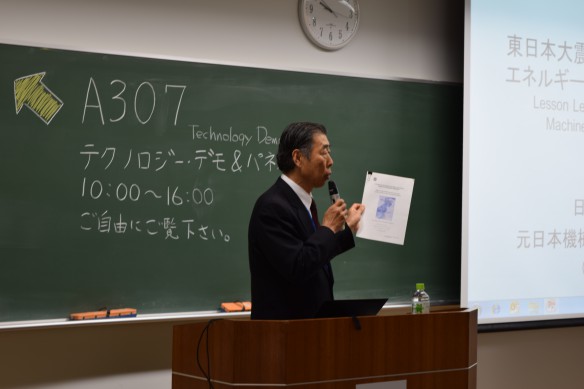
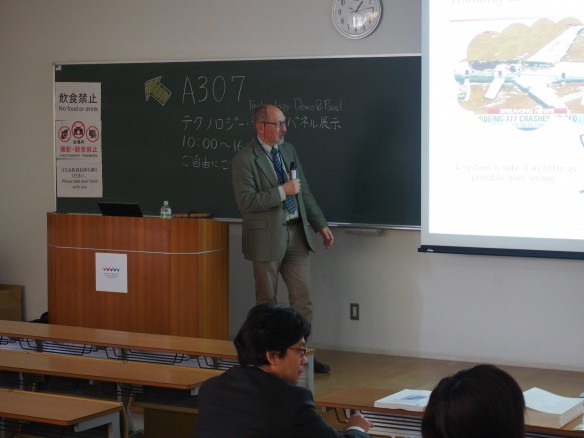
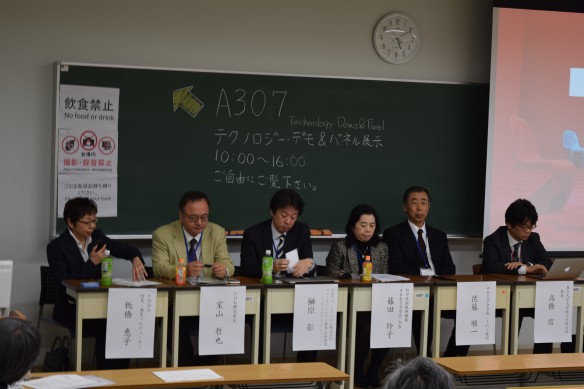
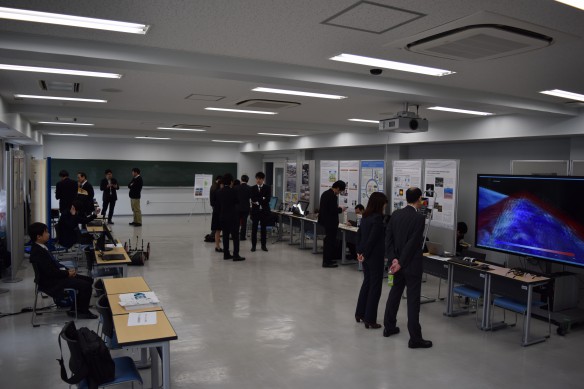
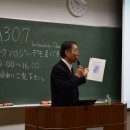
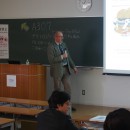
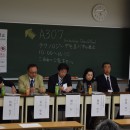
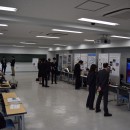
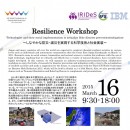 Flyer
Flyer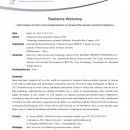 Program
Program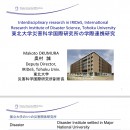 Makoto Okumura
Makoto Okumura Akira Doi
Akira Doi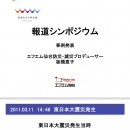 Keiko Itabashi
Keiko Itabashi Akira Sakakibara
Akira Sakakibara Jun-ichi Sato
Jun-ichi Sato Reiko Fujita
Reiko Fujita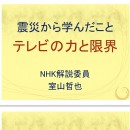 Tetsuya Muroyama
Tetsuya Muroyama

